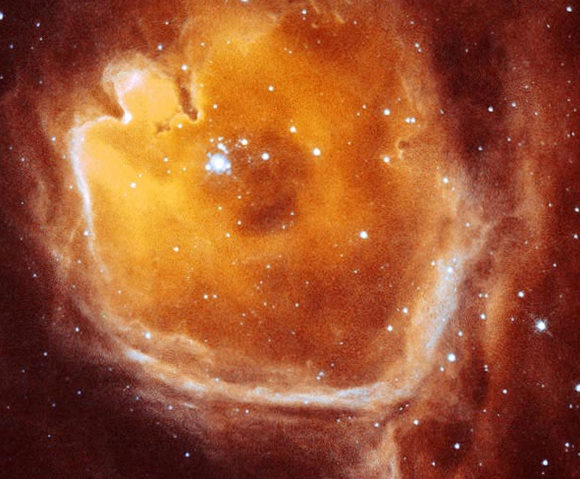Betcha thought I forgot about this week's "Where In the Universe" challenge. Sorry its late, but summer is the time for vacations and partaking in hobbies like rock hunting and late night stargazing. Here's an image that might provide the opportunity for both. That's just a little hint for this week's challenge. Your mission, should you choose to accept, is to name the location in the universe this image was taken, or maybe in this instance, what this is an image of. Give yourself extra points if you can name the spacecraft responsible for the image (that might be the easy part this week). No peeking below until you make your guess. And to be honest, I should say that this image is part of a larger image, which can be seen below.
[caption id="attachment_16560" align="alignnone" width="580" caption="image credit: Hubble Space Telescope"]
[/caption]
In this unusual image, the Hubble Space Telescope captures a rare view of the celestial equivalent of a geode -- a gas cavity carved by the stellar wind and intense ultraviolet radiation from a hot young star. The object, called N44F, is being inflated by a torrent of fast-moving particles --a stellar wind --from an exceptionally hot star once buried inside a cold dense cloud. N44F is located about 160,000 light-years in our neighboring dwarf galaxy the Large Magellanic Cloud, in the direction of the southern constellation Dorado.
Real geodes are baseball-sized, hollow rocks that start out as bubbles in volcanic or sedimentary rock. Only when these geodes are split in half by a geologist, do we get a chance to appreciate the inside of the rock cavity that is lined with crystals. In the case of Hubble's 35 light-year diameter "celestial geode" the transparency of its bubble-like cavity of interstellar gas and dust reveals the treasures of its interior.
Compared with our Sun, the central star in N44F is ejecting more than a 100 million times more mass per second. The hurricane of particles moves much faster at about 4 million miles per hour (7 million kilometers per hour), as opposed to about 0.9 million miles per hour (1.5 million kilometers per hour) for our Sun. Because the bright central star does not exist in empty space but is surrounded by an envelope of gas, the stellar wind collides with this gas, pushing it out, like a snowplow. This forms a bubble, whose striking structure is clearly visible in the crisp Hubble image.
How'd everyone do?
Find the original image
here.
 Universe Today
Universe Today
